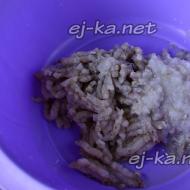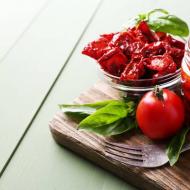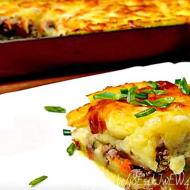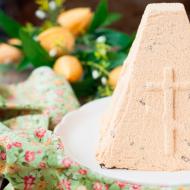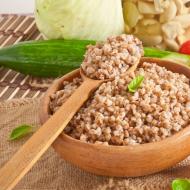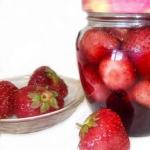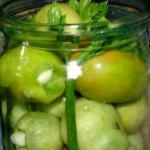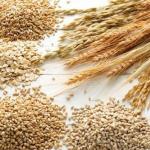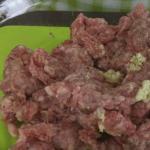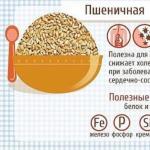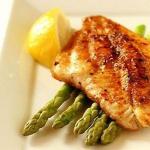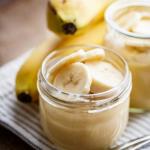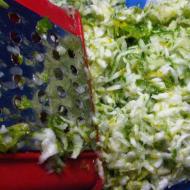
How to cook a miracle with meat in the oven. Chudu is a dish of Dagestan cuisine. How to cook Dagestan miracle with meat
1. Add soda to kefir at room temperature, stir and leave for 5 minutes.
2. In a deep bowl, mix 1 cup of flour, salt and kefir. Gradually adding the remaining flour, knead into an elastic, lump-free dough that does not stick to your hands. Cover the finished dough with a napkin and leave it alone until you prepare the filling.
3. Boil the potatoes in their jackets until tender, then cool slightly (the tuber can be picked up), peel and crush into dry puree (do not add oil or fat).
4. Grate the cheese on the finest grater.
5. Combine cheese and potatoes, add sour cream and chopped herbs (optional), lightly salt. Stir until smooth.
6. Divide the dough into 8 equal pieces, from which roll into balls.
7. Roll the balls into thin flat cakes, put the potato and cheese filling inside in the center of the flat cakes, pinch the top to form balls again.

8. Carefully, trying not to squeeze out the filling, roll out the balls into flat cakes.
 Flatbread before frying
Flatbread before frying 9. Heat a dry frying pan with a thick bottom. Fry each flatbread one by one on both sides (without oil).

10. Place the finished miracle with potatoes on a plate, lightly grease with butter. Cover to keep the tortillas warm and soft for a long time. Serve with sour cream.
If you wanted to surprise your loved one with a wonderful concoction, use miracle recipes. On the site there are options with boiled eggs, minced meat, salted cottage cheese, Adyghe and hard cheese, fresh herbs, potatoes and green onions. On water, kefir and meat broth. You can bake the flatbreads in the oven or fry them without oil in a frying pan.
Chudu is considered one of the favorite dishes in the Caucasus. These are thin, usually unleavened flatbreads with meat or cheese fillings. And to give the food a delicate taste, they are coated with butter while still hot. This dish will not leave anyone indifferent.
The five most commonly used ingredients in miracle recipes:
Simple recipe:
1. Knead kefir, flour and salt into a soft dough.
2. Finely chop the herbs: dill, cilantro, parsley, etc.
3. Mix greens with cottage cheese and raw eggs.
4. Add salt.
5. Cut the onion into half rings and fry.
6. Add to curd mixture.
7. For those who like it spicy, you can add ground pepper.
8. Roll out round cakes.
9. Place the filling.
10. Connect the edges.
11. Without greasing the pan with oil, fry the miracle on both sides.
12. Coat with butter.
Five of the fastest miracle recipes:
Helpful Tips:
. You can add green “feathers” or leeks instead of white onions.
. It is advisable to take thicker cottage cheese so that the dish does not turn out dry.
. Be sure to cover the finished cakes, otherwise they will become tough.
. The dish also goes well with sour cream and white sauces.
Yeast-free flatbreads with filling.
- 200 ml fermented milk product (kefir, fermented baked milk, etc.)
- 300 g flour (approx.)
- 0.5 tsp. soda
- 0.5 tsp. salt
- 500 g mashed potatoes
- 200 g feta cheese, Adyghe cheese (or cottage cheese in half with cheese)
- butter for greasing (50-100 g)
- sour cream for serving

Chudu (Dagestan flatbreads) are thin unleavened flatbreads with filling. The filling can be varied, I prepared potatoes with cheese, you can prepare a meat version (with fried minced meat, for example), as well as with herbs and cheese, and even pumpkin. All options will be good, depending on what you like best. By the way, many nationalities have this type of dish, for example, Khychin from Karachay-Balkar cuisine, Moldavian placinda, Bashkir kystyby, and Kutab from Azerbaijani cuisine, and Turkish and Indian cuisine also have detailed dishes. The fact that different nationalities have similar dishes only proves that it is very tasty.
I especially like these flatbreads because they are fried in a completely dry frying pan. This is why I love them much more than classic pancakes that are fried in oil.
I got 10 pieces.
Preparation:
Pour the fermented milk product into the container (I used fermented baked milk this time).
By the way, very often, instead of a fermented milk product, just water is used, and soda is not added at all. Kefir and soda make the finished cakes a little softer, but it also works great with water.
Add most of the flour, baking soda and salt.

Mix well with a spoon.

Place on a surface sprinkled with flour, knead the dough well, it should stop sticking to your hands, but remain soft. You may need a little more or less flour, depending on its moisture-absorbing properties.
Cover with a bag and leave to stand for 20-30 minutes, this will help the dough roll out better.

Add shredded cheese to mashed potatoes.
It works best with feta cheese or Adyghe cheese (which needs additional salt). But this time I didn’t have either one or the other on hand, so I used half and half cottage cheese with regular cheese. It turns out delicious with any filling.

Mix the filling well, add salt if necessary.

Divide the dough into 10-12 parts.
On a floured surface, roll out each piece as thinly as possible.

Place the filling on half.

Cover and press along the edge.
To trim off the excess, I used a curly knife.

Place the workpiece in a preheated and completely dry frying pan and fry over medium heat until golden spots on the bottom.
Chudu is a dish of Dagestan cuisine with a centuries-old history. It is a thin closed flat cake filled with a variety of fillings. There are other names depending on the region. For example, the Laks call her “kachi”. The miracle recipe is quite simple and takes little time both for cooking and for preparing the ingredients. Another plus is that the flatbread is fried in a frying pan without adding oil!
How to cook a miracle with potatoes
Among the most commonly used fillings in any pies, potato or meat occupy a special place. We suggest combining them, as in the recipe for a miracle with meat and potatoes.
So, when preparing the dish, you will need the following ingredients for the dough: 0.3 kg of flour, an egg and a little water. You also need to stock up on meat (0.3 kg) and three potatoes. Additionally, you should take 50 g of onion. Ground pepper, vinegar, salt and your favorite spices will help balance the taste.
Now we’ll explain step by step how to prepare the dish.
- Beat an egg into a suitable container, pour in a partial glass of water and a little salt. Shake everything thoroughly. Next, add flour and knead the dough. It should be cool. Roll into a ball, cover with a napkin and leave for half an hour.
- The meat is ground into minced meat, spices, pepper, salt, finely chopped onion are added to it and mixed until smooth.
- Right before preparing the flatbreads, peeled raw potatoes are grated, and then quickly mixed with minced meat, vinegar is added in an amount of 1 tsp. and stir vigorously, trying to mix everything thoroughly. If you hesitate, the potatoes will darken.
- The dough is divided into balls and rolled into a very thin cake.
- Now lay out the filling, fasten it into a “bag”, and then roll it out into a thin layer.
- All that remains is to fry the miracle with potatoes and meat, put it on a plate, grease it with oil, and serve.

Dagestan cuisine
There are a lot of recipes for miracles in Dagestan. There are traditional cooking techniques. But the rest depends on the hostess. The first thing to do is knead the dough. It can be anything: fresh, yeast
We will look at the miracle of kefir.
This will require 0.2 liters of kefir. This amount will use 2.5 tbsp. flour. Additionally, you need salt (0.5 tsp) and a little soda (only 1 tsp is enough).
To prepare a miracle, you need to take 0.25 kg of Adyghe cheese (if this is not available, replace it with what is available). You also need potato tubers (5 pcs.), aromatic herbs (quantity at your discretion) and 3 tbsp as a dressing. sour cream of any fat content. Grease the flatbreads with butter.
- The potatoes are thoroughly washed and boiled in their skins until tender.
- Meanwhile, kefir is poured into a container, salt is added, flour and soda are added and thoroughly kneaded into an elastic dough. It is rolled into a ball, placed in a deep container and covered with a napkin so that it does not dry out.
- Now let's start filling. Boiled potatoes are peeled and mashed.
- The cheese is grated on a grater with small holes.
- Add cheese, sour cream, herbs to the mashed potatoes and mix thoroughly until smooth. Don't forget to check for salt and adjust it to perfection. The filling for the miracle with cheese is ready.
- Divide the dough into 8 parts and roll into balls.
- Now take one “ball” at a time and roll it into a thin cake.
- The filling is placed in the center, the edges are collected in a “bag” and pinched.
- Heat a frying pan with a thick bottom.
- Roll out the resulting “bag” thinly into a flat cake and place it in a frying pan to fry on one side and then on the other.
- The finished miracles are placed on a plate and immediately greased well with oil.
Flatbreads are served with sour cream whole or cut into pieces. The principle of preparing other miracle recipes is similar.

Miracle with greens
Another popular miracle recipe is with herbs. This dish is made with the arrival of spring, when a lot of fresh greens grow. Spices are used: parsley, cilantro, basil, dill, green onions, garlic, etc. Miracle made from nettle has an original taste. It is permissible to use one type of greenery or make a “hodgepodge” of several varieties. The washed and chopped filling is mixed with grated cheese or cottage cheese. The taste is adjusted by spices. To make the filling juicy, it is recommended to pour a little sour cream or kefir into it. The technical side of preparing a miracle with cheese and herbs is similar to the recipes described above.
In principle, you can add greens to any filling as an additional component. It will highlight the taste of the flatbreads.
Once you have prepared this miracle, this dish will become a frequent guest on your table.
The cuisine of the peoples of Dagestan is fraught with an amazing feature - with a minimal set of ingredients and a fairly simple recipe, it allows you to prepare a large number of dishes, each of which will have a unique taste that is different from the others. Dagestan dishes are a colorful gastronomic mosaic with many unusual details.
The harsh conditions of mountain life and the need for long and difficult work in the fresh air could not but influence the recipe for cooking. very nutritious, easy to prepare, but healthy at the same time.
A striking example of the variety of variations collected in one dish is the Dagestan dish “Chudu”. This is a fragrant, thin closed pie that can be prepared with a wide variety of fillings. True, the Avars call this dish “chudu”; other Dagestan peoples have their own names, for example, the Laks call it “kachi”.
The uniqueness and versatility of these pies is that they can be prepared all year round, using the so-called seasonal fillings:
- In the spring, Dagestanis prepare them with an incredible amount of young greens of different types. This can be a miracle with nettles, green onions, halta (halta is one of the types of young grass) or beet tops.
- In summer, the filling is supplemented with fresh vegetables, new potatoes, soft cheese or cottage cheese;
- In the fall, the pumpkin miracle comes into its own. It is worth noting that this species is the pearl of Dagestan cuisine. The Dagestanis themselves love it and everyone who has had the chance to try it at least once.
- In winter, when food should be as dense and warming as possible, miracles are most often prepared with meat. It can be fresh or dried lamb or beef.
Miracle with chicken is prepared extremely rarely. Although, Lezgins have an amazing variety of holiday pie, which is filled with millet porridge with chicken.
There are also varieties of miracle stuffed with chicken and nuts, chicken and beans. These variations are very similar to Georgian cuisine, where chicken, beans and nuts are found in many dishes. And since miracle is also prepared in Ingushetia, Chechnya, and Kabardino-Balkaria, it can safely be called the Caucasian dish miracle.
In general, many types of miracles have a certain “national identity”. For example, “Dargin miracle”. Judging by the name, the idea for the recipe probably came to the Dargins. “Darginsky miracle” is a very popular, favorite dish in Dagestan. It differs from ordinary miracles in that it is not made into a thin, but a full-fledged, tall, closed pie, and is baked in the oven, and not fried in a frying pan, like the others. Dargins love to add walnuts to any miracle filling.
But at festive events it is customary to serve the Avar miracle - Botishchal. These are thin flatbreads stuffed with potatoes and cheese. The unusual thing about the boot is that the cheese added to the filling must stretch well when melted. The result is the most delicate, thin cakes that simply melt in your mouth.
The most delicious are miracles cooked in ancient wood-burning ovens. Unfortunately, you can no longer find them in the city. And in villages these stoves have been preserved and are successfully used by many housewives.
The dough used for preparation is unleavened, yeast-free, with the exception of the Dargin miracle, for which the dough must be either kefir or yeast. Fry the miracle in a dry frying pan without adding oil. In order for the finished miracle to become soft, immediately after baking it is coated with melted butter. You can, of course, use butter or sour cream for this purpose, but the taste will be slightly different.
For any miracle dish, the dough recipe will, in principle, look the same, but the filling recipes will differ. The exception, as already mentioned, will only apply to the dough recipe for the Darginsky miracle.
Dargin miracles
To prepare the kefir dough you will need:
- kefir –0.5 liters;
- soda – 1 teaspoon;
- salt 1.5 teaspoons;
- flour – 1 kg (this is approximately 5 glasses of 200 g each).
All ingredients are mixed, the dough is left to rest for 10 minutes, and you can start baking.
Yeast dough for Dargin miracles
- flour - 1 kg (a little more flour will be needed when rolling);
- warm milk – 0.5 liters;
- butter – 200-205g;
- a packet of yeast (25 g);
- sugar – 1 teaspoon;
- salt – 0.5 tsp. spoons;
- soda – 1/3 tsp. spoons.
The dough is kneaded, covered with a napkin and placed in a cool place (or in the refrigerator) for half an hour. Then you can start rolling out. You shouldn’t get too carried away with adding flour, as the dough should be soft.

The filling for the Dargin miracle is prepared from potatoes, cut into thin slices and thinly sliced pieces of lamb or beef (not minced meat). Quite often, Dargin pies are prepared with dried meat, but this option is not for everyone. To make the miracle juicy, it’s a good idea to add a little fat to the meat. In Dagestan, fat tail fat is often added.
If fatty meat is contraindicated for some reason, then about half a glass of any broth is poured into the small hole in the upper part. During the baking process, the potatoes absorb the broth and become soft and juicy.
The dough is rolled out into two circles. The filling is laid out on the first one, then it is covered with the second circle, and the edges are pinched into a neat braid. The pie is baked in the oven for about an hour. To get a beautiful and golden brown crust, the top of the pie can be brushed with egg.
Classic thin miracle
Preparation of the dough for thin miracles is as follows:
- 500 gr. flour mixed with a glass of water, added to taste;
- a dense soft dough is kneaded;
- The dough is covered with a towel and left to rest for 15 minutes.
Next, the dough is divided into small pieces, each of which is rolled out into a very thin circle. The filling is laid out on one half of the circle, the filling is closed with the other half and neatly but tightly sealed. The pinching process can be simplified if you cut off the edge of the miracle with a figured roller knife. It will hold the edges together and give the product a beautiful shape.
The miracle is fried in a dry frying pan, alternately on each side, until golden brown. The finished product is lubricated with oil.

Fillings for thin miracle
- Meat. Minced lamb or beef is mixed with onions minced through a meat grinder. Salt, pepper or other spices are added to taste.
- Green stuffing. Finely chopped greens are mixed with cottage cheese or soft cheese. If desired, you can add a little sour cream or kefir, so the filling will be more juicy. Add salt and, if desired, pepper.
- Potato and cheese filling for Botischal. The potatoes are boiled and mashed into a nice, homogeneous puree. Grated cheese is added to it. It can be young cheese or Ossetian cheese. If the cheese is salty, then there is no need to add salt to the filling. The ratio of cheese and potatoes is selected individually, according to your preferences. The secret of this filling is that you must add a small amount of quicklime soda, literally at the tip of a teaspoon. It is this trick that will make the cheese more viscous.
- Pumpkin filling. The pumpkin is grated on a fine grater, mixed with finely chopped walnuts, as well as lightly fried onions. Salt, pepper, and spices are added to taste, but nutmeg is especially good here.
Miracle is a dish with a centuries-old history. Those who have tried it once will definitely want to continue to discover all its variations.

